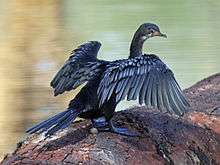Reed cormorant
| Reed cormorant | |
|---|---|
.jpg) | |
| Scientific classification | |
| Kingdom: | Animalia |
| Phylum: | Chordata |
| Class: | Aves |
| Order: | Suliformes |
| Family: | Phalacrocoracidae |
| Genus: | Microcarbo |
| Species: | M. africanus |
| Binomial name | |
| Microcarbo africanus (Gmelin, 1789) | |
| Synonyms | |
|
Plotus nanus | |
The reed cormorant (Microcarbo africanus), also known as the long-tailed cormorant, is a bird in the cormorant family Phalacrocoracidae. It breeds in much of Africa south of the Sahara, and Madagascar. It is resident but undertakes some seasonal movements.
Description

This is a small cormorant at 50–55 cm length and an 85 cm wingspan. It is mainly black, glossed green, in the breeding season. The wing coverts are silvery. It has a longish tail, a short head crest and a red or yellow face patch. The bill is yellow.
Sexes are similar, but non-breeding adults and juveniles are browner, with a white belly. Some southern races retain the crest all year round.
Behaviour
The reed cormorant can dive to considerable depths, but usually feeds in shallow water. It frequently brings prey to the surface. It takes a wide variety of fish. It prefers small slow-moving fish, and those with long and tapering shapes, such as mormyrids, catfishes, and cichlids. It will less frequently eat soles (which can be important in its diet locally), frogs, aquatic invertebrates, and small birds.
Two to four eggs are laid in a nest in a tree or on the ground, normally hidden from view by long grass.
Habitat
This is a common and widespread species, and is not considered to be threatened. It breeds on freshwater wetlands or quiet coasts.
References
| Wikimedia Commons has media related to Microcarbo africanus. |
- BirdLife International (2004). "Phalacrocorax africanus". IUCN Red List of Threatened Species. Version 2006. International Union for Conservation of Nature. Retrieved 12 May 2006.
- Johnsgard, Paul A. (1993). Cormorants, Darters, and Pelicans of the World. Washington: Smithsonian Institution Press. ISBN 1-56098-216-0.
- Seabirds by Harrison, ISBN 0-7470-1410-8
- Birds of The Gambia by Barlow, Wacher and Disley, ISBN 1-873403-32-1
External links
- Reed Cormorant - The Atlas of Southern African Birds
- Reed cormorant - Species text in The Atlas of Southern African Birds.
